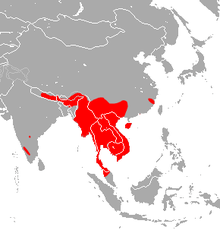Pomona roundleaf bat
| Pomona roundleaf bat | |
|---|---|
 | |
| Scientific classification | |
| Kingdom: | Animalia |
| Phylum: | Chordata |
| Class: | Mammalia |
| Order: | Chiroptera |
| Family: | Hipposideridae |
| Genus: | Hipposideros |
| Species: | H. pomona |
| Binomial name | |
| Hipposideros pomona Andersen, 1918 | |
 | |
| Pomona roundleaf bat range | |
The Pomona roundleaf bat, Pomona leaf-nosed bat, or Andersen's leaf-nosed bat (Hipposideros pomona) is a species of bat in the family Hipposideridae. It is found in Bangladesh, Cambodia, China (southern), India, Laos, Malaysia (Peninsular), Myanmar, Nepal, Thailand and Vietnam. It roosts in small colonies, consisting of a few individuals, in caves and crevices. It appears to tolerate modified habitats well, even occurring in urban areas.[1]
Taxonomy
It was described as a new species in 1918 by Danish mammalogist Knud Andersen. The holotype had been collected in what was then the Coorg Province of India by G. C. Shortridge.[2] The Vietnam leaf-nosed bat, Paracoelops megalotis, formerly known as its own species based on one specimen, is now recognized as synonymous with the pomona roundleaf bat. In 2012, researchers determined that all the features of P. megalotis match the pomona roundleaf bat. Their skulls and teeth were identical, and the P. megalotis specimen is indistinguishable from pomona roundleaf bat individuals.[3] The Integrated Taxonomic Information System, responsible for managing taxonomy of species, no longer recognizes Paracoelops as a valid genus nor P. megalotis as a valid species.[4]
Description
Its forearm length is approximately 39–43 mm (1.5–1.7 in).[5]
Range and habitat
It is widely distributed throughout Asia. It has been documented in Bangladesh, Cambodia, China, India, Laos, Malaysia, Myanmar, Nepal, Thailand, and Vietnam. Its upper elevation limit is 1,900 m (6,200 ft) above sea level.[1]
Conservation
As of 2008, it is evaluated as a least-concern species by the IUCN. It meets the criteria for this assessment because it has a wide geographic range; its population is presumably large; it is unlikely to be experiencing rapid population decline; and it tolerates some human disturbance of its habitat.[1]
References
- 1 2 3 4 Bates, P.; Bumrungsri, S.; Csorba, G.; Molur, S. & Srinivasulu, C. (2008). "Hipposideros pomona". The IUCN Red List of Threatened Species. 2008: e.T10154A3176231. doi:10.2305/IUCN.UK.2008.RLTS.T10154A3176231.en. Retrieved 15 January 2018.
- ↑ Andersen, K. (1918). "Diagnoses of new bats of the families Rhinolophidae and Megadermatidae". The Annals and Magazine of Natural History; Zoology, Botany, and Geology. 9. 2: 381.
- ↑ Thong, V. D.; Dietz, C.; Denzinger, A.; Bates, P. J.; Puechmaille, S. J.; Callou, C.; Schnitzler, H. U. (2012). "Resolving a mammal mystery: the identity of Paracoelops megalotis (Chiroptera: Hipposideridae)" (PDF). Zootaxa. 3505 (1): 75–85.
- ↑ "Paracoelops megalotis Dorst, 1947". itis.gov. ITIS. 2017-12-02. Retrieved 2017-12-02.
- ↑ Zhao, Le-Zhen; Bu, Yan-Zhen; Zhou, Hui-Xian; Zhou, Hong-Wei; Zhang, Zong-Xiao; Niu, Hong-Xing (2015). "Differences in Hipposideros pomonafrom three geographical regions in China based on morphology and molecular sequences data". Journal of Mammalogy. 96 (6): 1305–1316. doi:10.1093/jmammal/gyv139.
